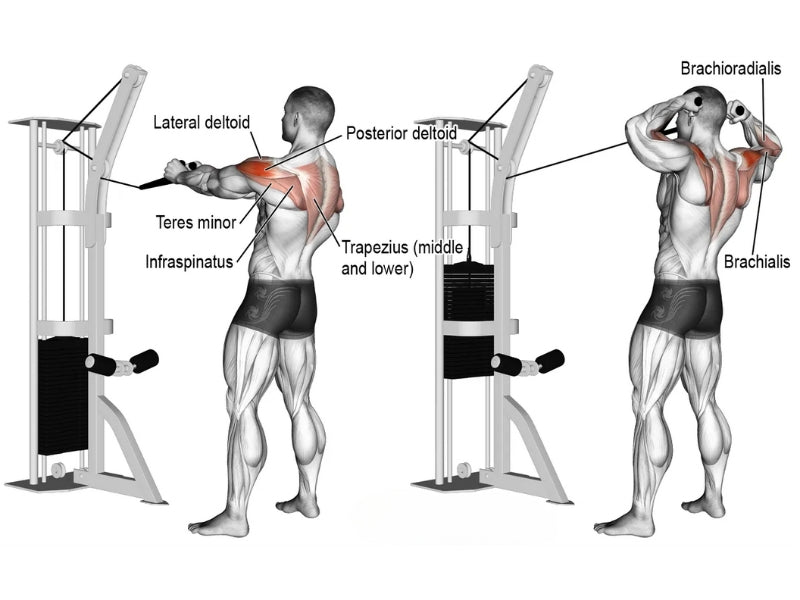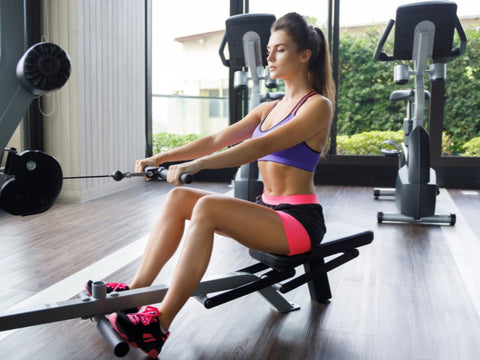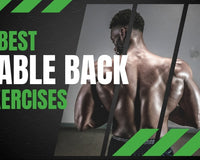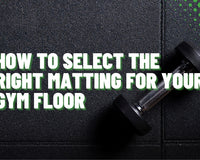If you've never heard of the face pull before, then you're in the right place, because this is a fantastic exercise for your shoulders and upper back, one that you certainly don't want to miss out on.
Today, we're going to take a much closer look at the face pull exercise, what a face pull is, what its benefits are, and which muscles are worked.
We’ll also provide you with a step-by-step guide on how to do face pulls, along with some tips, as well as mistakes to avoid.
This will help ensure you perform each rep with the correct form and generate the most muscle activation possible.
What is a Face Pull?

The face pull is an exercise that sees you using a pulley machine, with the pulley adjusted to the highest level, and a rope attachment hooked onto it.
You hold the rope attachment with your thumb and pointer finger facing towards you and your pinkies facing away from you.
You then slowly pull the rope towards your face, and as you get to your face, you split your arms and hands to either side of your face, with your hands ideally reaching your level at the rear of the exercise. Then slowly returning to the starting position in a controlled manner.
The Benefits of Face Pulls
Before adding any exercise into your routine you might be wondering what the benefits of face pulls are.
Firstly, if you're looking to build some muscle in your upper body, particularly in your shoulders, rear delts, traps, and lats, then it's a fantastic exercise.
If you're looking for that rounded and muscular upper body, you'll need to do a lot of face pulls.
Another benefit that you get from doing face pulls is that it helps to keep your shoulder in good condition.
If you do a lot of overhead movements, such as shoulder presses, you might end up injuring your shoulder.
However, the face pull exercise assists in stabilizing the shoulder muscles, as well as strengthening them, therefore preventing injuries from occurring.
Overall, doing face pulls on a regular basis can help you maintain a good range of motion and a high level of mobility in your shoulders.
Face Pull - Muscles Worked

Face pulls are quite diverse in terms of the muscles that they exercise.
First and foremost, your posterior deltoids or rear shoulder muscles are worked out heavily during this exercise and are perhaps the number one most engaged muscle.
Your rotator cuff, lateral deltoids, and traps also get engaged here. Depending on how you hold the rope, you might even engage your lats or latissimus dorsi to a certain degree.
If you maintain proper form during this exercise, you can effectively target all of these muscles at the same time.
Furthermore, if you're using a heavy weight, and you are being forced to balance so that the rope and weight doesn't pull you forward, you'll also end up engaging your quadriceps muscles, your lower back, and your core.
How to do Face Pulls

Let's now go through a quick step-by-step tutorial on exactly how to do face pulls.
- Start by positioning a cable machine so that the pulley is at its top position. Attach a rope accessory, as this is the only piece of equipment you can use for a face pull.
- If you've never done this exercise before, start with a lightweight, something like 15 or 20 lbs. You can always increase the weight if you feel that it's too light.
- Stand facing the cable machine with your feet shoulder-width apart.
- Start by holding the rope so that the knuckles of your thumb and pointer finger are facing you, with your pinkies and the outsides of your wrist facing away from you. Hold it at roughly face level.
- While leaning backwards a little bit to stabilize yourself, slowly pull the rope towards your face with both handles.
- As you move towards your face, you're going to split your hands apart so that your fists end up on either side of your head, preferably at roughly ear level.
- If you really want the maximum amount of muscle activation possible, hold this position for a second or two and really squeeze your shoulders and back muscles.
- In a slow and controlled manner, return to the starting position.
Mistakes to Avoid and Tips for Doing Face Pulls Properly
Let's go over a few crucial tips in terms of form and position so you can do the face pull properly.
- Make sure that you're standing a couple of steps back from the machine. When you start this exercise, even in the starting position, there should already be tension on the rope.
- It is best to stand with your feet shoulder-width apart, although some might prefer to place one foot in front of the other for balance. That said, be sure to keep your upper body straight and in line, or else you may work out one side more than the others.
- When you perform this exercise, make sure to rotate your forearms up and keep your elbows high.
- Don't pull the rope towards your chest instead of your head, and make sure to lift your forearms up, because if you don't, the exercise will end up being too easy, and you'll end up targeting the incorrect muscles.
- The face pull is one of these exercises where it's really easy to cheat, so it's best to start with a lower weight, so you don't have to compensate with other muscles too much.
Alternatives to Face Pulls
Let's take a quick look at 3 alternatives to face pulls that you can do to work out similar muscles.
Cable Rear Delt Row

The cable rear delt row is very similar to the face pull exercise, but the difference is that your forearms don't rotate upwards. It's therefore more of a rear deltoid row that helps to engage your trapezius muscle a lot more than a face pull alone.
Barbell Rear Delt Row

The barbell rear delt row is a great exercise if you're looking to target your rear deltoid muscles. The point here is to bend over and row a barbell up from the ground to high up on your chest.
Dumbbell Rear Delt Row
Just like the barbell rear delt row is great for exercising your deltoids, so is the dumbbell rear delt row. Here, you use a pair of dumbbells and pull them upwards, so that your hands and dumbbells end up on either side of your body. Depending on how you do it, it can also be a good lats exercise.
Rounding Up
The face pull might be an extremely simple exercise, but it's also very important for shoulder mobility, and it's great for strengthening those shoulder and back muscles as well.





